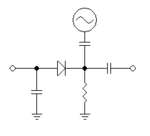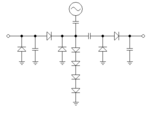neazoi
Advanced Member level 6
Hi I have built this little circuit and I notice a weird behaviour which I would like to discuss.
The rf generator works on HF. The resistor is 1k and the capacitors 100nf.
When the left port is left unconnected I measure about -1v DC at the left port and about 2vpp at the right port.
When a DC is applied to the left port, I measure a lower voltage (~1vpp) on the right port.
What is going on?
Is there any way that the DC that passes through the resistor somehow saturates it and causes more RF to flow through it to the ground instead of the right port?
The rf generator works on HF. The resistor is 1k and the capacitors 100nf.
When the left port is left unconnected I measure about -1v DC at the left port and about 2vpp at the right port.
When a DC is applied to the left port, I measure a lower voltage (~1vpp) on the right port.
What is going on?
Is there any way that the DC that passes through the resistor somehow saturates it and causes more RF to flow through it to the ground instead of the right port?


